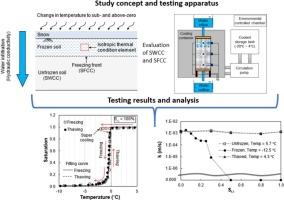用环境控制柱试验评价冻结砂土的保水特性
IF 3.8
2区 工程技术
Q1 ENGINEERING, CIVIL
引用次数: 0
摘要
冻土区土壤冻结特征曲线(SFCC)、土壤水分特征曲线(SWCC)和水力传导性是了解寒区水分入渗和气候变化的重要依据。在本研究中,开发了一种新的实验系统,同时研究了沙土在冻结和融化阶段的SFCC、SWCC和水力传导性。在冻结和解冻过程中测量SFCC和SWCC,而在未冻结、冻结和解冻条件下评估水力传导性。结果表明,过冷效应导致冰点降低约2°C,在SFCC和SWCC中观察到明显的滞后,特别是在100%初始饱和时(Sr,i)。冻结期间的入冰值(IEV)与Sr,i成反比,当Sr,i从50%增加到100%时,IEV的值下降了25%。冻结时的水导率明显低于解冻或未冻结状态,在Sr时下降高达80%,由于孔隙冰的形成,水导率≥30%。冻融阶段的IEV和进风值(AEV)的差异归因于相变过程中的潜热交换。本研究强调了冻融循环下SFCC、SWCC和水力传导性的相互关联行为。这些发现增强了我们对冻融循环下土壤行为的理解,并为改进冻土水分入渗模型提供了关键数据。本文章由计算机程序翻译,如有差异,请以英文原文为准。

Evaluation of water retention characteristics in frozen sandy soils using an environmentally controlled column test
Water retention properties in frozen soils, including the soil freezing characteristic curve (SFCC), soil water characteristic curve (SWCC), and hydraulic conductivity, are crucial for understanding water infiltration and climate change in cold regions. In this study, a novel experimental system was developed and conducted to simultaneously investigate the SFCC, SWCC, and hydraulic conductivity of sandy soils during the freezing and thawing phases. SFCC and SWCC were measured during freezing and thawing, while hydraulic conductivity was assessed under unfrozen, frozen, and thawing conditions. The results showed that supercooling effects cause a freezing point suppression of approximately 2 °C, with significant hysteresis observed in SFCC and SWCC, especially at 100 % initial saturation (Sr,i). The ice-entry value (IEV) during freezing was determined to be inversely proportional to Sr,i, with values decreasing by up to 25 % as Sr,i increased from 50 % to 100 %. Hydraulic conductivity during freezing was significantly lower than in thawing or unfrozen states, decreasing by up to 80 % at Sr,i ≥ 30 % due to pore ice formation. Differences in the IEV and air-entry value (AEV) between freezing and thawing phases were attributed to latent heat exchanges during phase transitions. This study highlights the interconnected behaviors of SFCC, SWCC, and hydraulic conductivity under freeze-thaw cycles. These findings enhance our understanding of soil behavior under freeze-thaw cycles and provide critical data for improving water infiltration models in frozen soils.
求助全文
通过发布文献求助,成功后即可免费获取论文全文。
去求助
来源期刊

Cold Regions Science and Technology
工程技术-地球科学综合
CiteScore
7.40
自引率
12.20%
发文量
209
审稿时长
4.9 months
期刊介绍:
Cold Regions Science and Technology is an international journal dealing with the science and technical problems of cold environments in both the polar regions and more temperate locations. It includes fundamental aspects of cryospheric sciences which have applications for cold regions problems as well as engineering topics which relate to the cryosphere.
Emphasis is given to applied science with broad coverage of the physical and mechanical aspects of ice (including glaciers and sea ice), snow and snow avalanches, ice-water systems, ice-bonded soils and permafrost.
Relevant aspects of Earth science, materials science, offshore and river ice engineering are also of primary interest. These include icing of ships and structures as well as trafficability in cold environments. Technological advances for cold regions in research, development, and engineering practice are relevant to the journal. Theoretical papers must include a detailed discussion of the potential application of the theory to address cold regions problems. The journal serves a wide range of specialists, providing a medium for interdisciplinary communication and a convenient source of reference.
 求助内容:
求助内容: 应助结果提醒方式:
应助结果提醒方式:


